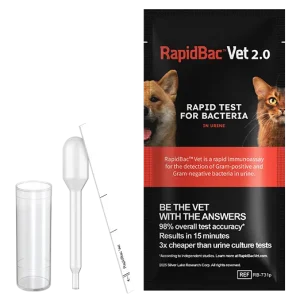
Dr. Liv Kismartoni
How long have you been using RapidBac™Vet ?
DR. LIV:
We’ve had the test at the clinic for about two years. Once I learned “when” (which cases) to use it, I, personally, have been using the RapidBac™Vet test regularly for about a year.
Why did you originally purchase RapidBac™Vet ?
DR. LIV:
The medical director at the clinic had heard about it and brought it up at rounds. We discussed it and decided it would be a valuable tool at our vet clinic.
Who in the clinic actually performs the test?
DR. LIV:
Our vet assistants and technicians.
Do you think that RapidBac™Vet is a trustworthy alternative to microscopic urinalysis (or other methods) for detecting bacteriuria?
DR. LIV:
The RapidBac™Vet test is much more sensitive than a urinalysis. It is a culture without identifying the bacteria. I think the best way to convince my colleagues would be to recommend they use it on the cases where they don’t necessarily trust a negative on a urinalysis, to confirm a UTI has resolved, on a newly diagnosed diabetic/renal disease/Cushingoid patient, or to determine bacteriuria in a patient with dilute urine.
What do you do when you get a positive result with RapidBac™Vet ?
DR. LIV:
Unless this is an infection that has not responded to antibiotics, I will treat with antibiotics and retest with a RapidBac™Vet after treatment.
If this is on a urine sample from a patient with a recent infection that has not resolved, or is recurrent, a culture and sensitivity to the lab is indicated.
What do you do when you get a negative result with RapidBac™Vet ?
DR. LIV:
I can trust the patient doesn’t have a urinary tract infection.
How do you use RapidBac™Vet t in cases of diabetic patients?
DR. LIV:
I use RapidBac™Vet as a screening tool for UTIs for diabetics (and anyone with a chronic disease that causes dilute urine). It is not infrequent that I find silent UTIs by using this test; in fact, based on clinical signs, I suspected one of my diabetic patients had a UTI.
I left instructions in the medical record to run a RapidBac™Vet test. Since we had accidentally run out of RapidBac™Vet tests, they ran a urinalysis in-house, which did not show bacteria or other evidence of a UTI (no WBCs, protein, nor blood). I was fairly certain this patient did have a UTI, so since we were out of the in-house RapidBac™Vet tests, I asked them to send in the urine for a culture and sensitivity to the lab.
They accidentally sent the urine in for a “urinalysis and culture & sensitivity ‘if indicated.’” The result I received that same day was a negative urinalysis. I asked the technician to call the lab and request a culture and sensitivity, not a “urinalysis and a C & S if indicated.” They ran the culture, and the urine did, in fact, grow E. coli.
I was able to treat the patient and resolve the clinical signs (which included problems with her glucose regulation). This was an example of how I really needed RapidBac™Vet in my clinic that day!
Would you use RapidBac™Vet in emergency/24-hour care?
DR. LIV:
It is a very fast and trustworthy test for identifying bacteria in urine. Much, much more sensitive than running a urinalysis in-house or on the Sedivue (we also have a Sedivue in our clinic, and unfortunately, at this time, can’t trust the microscopy).
What advice would you have for veterinarians who are considering RapidBac™Vet ?
DR. LIV:
The best recommendation I have is to put a note somewhere to remind you to use it when you first get it in the hospital. I regret not figuring out its usefulness for a year!
The RapidBac™Vet is a very accurate and sensitive test to detect bacteria in urine. I run it in addition to urinalyses, as well as in place of them when I don’t need all of the other information (and just need to know if my patient has bacteriuria).
ABOUT DR. LIV
Dr. Liv earned her Bachelor’s and Master’s degrees in Public Health from the University of Illinois at Chicago. She graduated from the University of Wisconsin’s Veterinary School in 2010.
As a former professional dog trainer and competitor in dog sports, she followed her passion and earned certifications in veterinary acupuncture at the Chi Institute, physical rehabilitation (similar to physical therapy for humans), and veterinary spinal manipulative therapy (animal chiropractic).

